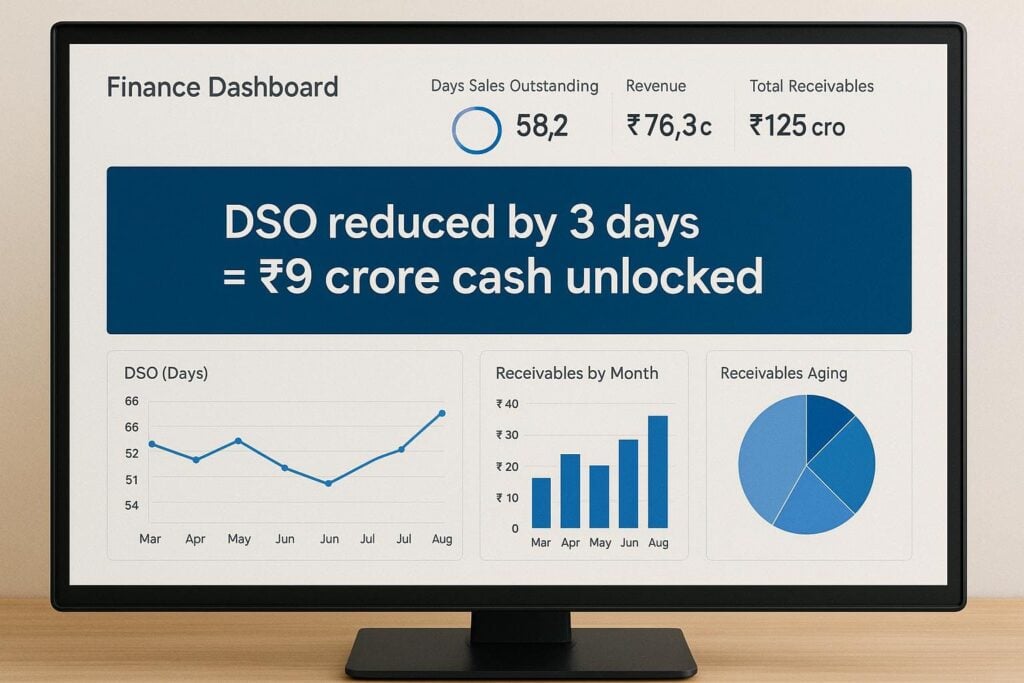11 Min Read
Receivables: Capital’s Weakest Link

Receivables are where many Indian mid-market enterprises quietly lose capital strength. ERP systems, Tally, distributor portals, and spreadsheets coexist but rarely connect. Orders ship on time, yet invoices lag. Consequently, cash flow weakens.
Only 30% of the invoice value in India is paid on time. 63% remain overdue. 7% is written off as bad debt. This makes India one of the riskiest B2B payment environments in Asia.
For promoters and CFOs, this gap does not appear in the EBITDA slides. It appears when banks tighten covenants, when working capital limits shrink, and when interest spreads rise.
Receivables are not just paperwork. They are collateral.
Invoices Go Missing

The first hindrance to increasing working capital is lost invoices. For example, a production line may complete an order, and trucks roll out. Yet finance waits days to raise an invoice. Customer master data mismatches or GST wording errors trigger weeks of reconciliation.
This is not anecdotal. 1 in every 3 B2B SMB invoices generated are usually rejected because of rather small and negligent errors. A missed invoice freezes crores of cash, distorts reporting, and raises doubts with lenders.
Manufacturing scenario:
A ₹700 crore auto-components supplier using SAP for production and Tally for statutory compliance discovered that 3% of dispatches were missing invoices until month-end checks. 3% sounds small, but at their scale, it meant nearly ₹20 crore frozen every quarter.
When the company applied for an unsecured top-up loan, the bank flagged reporting inconsistencies. The CFO realised invoicing was a capital risk, not just a clerical error.
Playbook for invoice integrity:
• Link order fulfillment directly to invoice generation.
• Run daily reconciliation between ERP and Tally.
• Flag unbilled shipments automatically in real time.
• Escalate exceptions within 24 hours.
• Lock changes behind role-based approvals and keep an immutable log.
Collections Drag Out

The second hindrance is overdue receivables. Proof of delivery often sits in transporter apps or WhatsApp threads. Distributors extend credit informally. A single GST mismatch can block collections for weeks.
Research shows that nearly 52% of B2B payments in Hyderabad, Kolkata, Chennai, and Pune have been overdue for more than 90 days. This figure paints a dire picture of the financial strain faced by many MSMEs in these cities.
The backlog is staggering. As of October 2024, over ₹21,108 crore in payments were pending to SMEs on the government’s MSME Samadhaan portal across 90,000 cases.
Healthcare scenario:
A diagnostics chain across five cities, with 18% EBITDA margins, faced insurer payment delays of fifteen days or more. Claim formats varied, attachments went missing, and finance had no live view of disputes.
Liquidity dried up even while volumes grew. The CFO had to tap short-term loans to cover payroll. Lenders saw operational slippage, not financial discipline.
Playbook for faster collections:
• Digitise proof-of-delivery capture across channels.
• Standardise credit terms in distributor agreements.
• Automate GST field validation.
• Track Days Sales Outstanding daily.
Loans Get Costlier

The third hindrance is borrowing costs. Banks and NBFCs interpret slow receivables as weak discipline.
The bias is visible. Among the 64 million MSMEs in the country, only 14% have access to credit. Banks exclude receivables older than 90 days from drawing power.
Policy pressure compounds the pain. The MSME law requires buyers who delay payments beyond 45 days to bear a tax liability on the overdue amount.
Logistics scenario:
A ₹900 crore fleet operator applied for a ₹120 crore working capital line. The bank cut assessed drawing power by 20% because one-third of receivables were more than 90 days overdue.
This decision added 85 basis points to their borrowing cost. The CFO called it their most expensive mistake of the year.
Playbook for credit readiness:
• Keep receivables ageing buckets clean.
• Prioritise more-than-ninety-day debtors for recovery.
• Produce lender-ready MIS every month.
• Pre-package receivables proof for credit committees.
Capital Gets Trapped

The fourth hindrance is idle capital. Every extra day of days sales outstanding (DSO) immobilises two to three crore rupees for a mid-cap enterprise. Over a quarter, 15 to 20 crores sit idle, not reducing debt or funding growth.
In an older report, EY estimated that Indian corporates hold ₹5.3 trillion, about 12% of sales, unnecessarily tied up in working capital.
India Ratings put it bluntly: “If the working capital cycle keeps lengthening… equity raises lower RoCE while debt pushes up interest cost.”
Consumer brands scenario:
A ₹1,100 crore packaged foods company carried an average DSO of 78 days. That meant ₹60 crore blocked in receivables at any given time. With input inflation rising, the firm borrowed expensive short-term credit.
Contribution margins fell by 90 basis points. The CFO admitted receivables discipline was worth more than their marketing budget.
Playbook for capital release:
• Monitor DSO at the board level.
• Quantify the rupee value of each day in cash.
• Set working capital improvement targets.
• Tie receivables KPIs to management incentives.
Stop Invoice Loss
The most direct win against all these hindrances is invoice integrity. Every fulfilled order must trigger an invoice, without waiting for end-of-day batches or human follow-ups.
In India, about 60% of MSMEs report facing significant delays in receiving payments from clients, with an average delay of 90 to 120 days.
Many of these delays are rooted in invoice disputes.
Manufacturing solution scenario:
A precision castings maker integrated dispatch events from SAP with a small middleware service that posted pre-validated invoice data into Tally every hour. A reconciliation bot compared truck challans, e-way bills, and ERP deliveries, and raised a task if a delivery lacked a matching invoice after 120 minutes.
Within six weeks, unbilled shipments fell to near zero. Month-end spillovers disappeared. The credit team could show a clean audit trail in its lender pack.
Playbook: invoice integrity
• Mirror fulfillment events into a billing queue in real time.
• Pre-validate GST fields, customer masters, ship-to, and bill-to.
• Auto-generate invoices on timer thresholds; flag exceptions instantly.
• Review an “unbilled-but-delivered” dashboard twice daily.
• Lock changes behind role-based approvals; keep an immutable log.
Predict Risk Early
Collections should be proactive. With India’s overdue share at 63% and bad debt around 7%, ageing alone is not enough. Teams need early warnings that specific invoices will slip so they can intervene before due dates.
Healthcare solution scenario:
A diagnostics network trained a simple model on payer behaviour, incorporating insurer, plan type, speciality, location, original claim value, missing-document history, and turnaround times. The model scored each new claim for delay risk and opened a task when risk exceeded a threshold. Typical triggers were missing attachments, form changes for a payer, or proof of delivery (POD) anomalies.
Collections cut eleven days off the average lag. Finance could now predict next month’s receipts with far tighter bands, which improved internal liquidity planning.
Playbook: predictive collections
• Create a payer or debtor risk score refreshed daily.
• Define pre-due-date playbooks for the top three risk reasons.
• Route risky invoices to owners with SLA clocks.
• Instrument POD events at source; attach proof to the invoice record.
• Meet weekly on variance — forecast versus actual — and close root causes.
Tie Accounts Receivable (AR) To Working Capital

Receivables dashboards must speak the language of capital. The CFO should be able to show that reducing DSO by three days releases between 6 crore and 9 crore rupees for a 1000 crore business, strengthens debt service coverage ratio (DSCR), and shrinks spreads in the next renewal cycle.
India’s long cash-conversion cycles versus the US and Europe make this link essential.
Consumer brands solution scenario:
A packaged foods company mapped its receivables drivers to covenants: fill rate and returns affected contribution; contribution and DSO affected DSCR. The CFO took a one-pager to lenders: “DSO down three days equals 9 crore cash unlocked; DSCR up 0.3x; interest-coverage up 0.4x.”
Approval came with no new covenants. The team began treating collections as a capital lever, not just a finance KPI.
Playbook: AR-to-capital
• Quantify the rupee value of each DSO day.
• Map two or three operational drivers to DSO and contribution.
• Publish a weekly sheet: cash unlocked and covenant protection.
• Share snapshots with banks during quarterly interactions.
• Tie leadership bonuses to DSO and covenant health in addition to volume.
Fix Without IT Lag
Indian teams cannot wait months for ERP changes when the Reserve Bank expects receivable statements that are current; stale statements can make drawing power irregular.
Logistics solution scenario:
A surface-transport operator found repeat GST mismatches blocking invoices. Instead of a long ERP project, the team added a thin rules layer: validate GST fields against master data at dispatch, require POD and lorry receipt (LR) images before invoice submission, and auto-route exceptions to the regional head.
Disputes fell by 70%. Aged debt shrank, and the bank restored 20% of previously deducted drawing power.
Playbook: change agility
• Put a governed workflow layer in front of billing and collections.
• Add validation where errors originate; push fixes to the edge.
• Keep version control and audit logs for every policy change.
• Measure time-to-change as a KPI: hours and days, not quarters.
• After stability, move high-value rules into the ERP proper.
Build Lender Proof
What convinces a credit committee is repeatability and traceability. Many Indian SMEs still await ₹21,108 crore in overdue payments. Lenders want to know that your receivables will not become part of that backlog.
Banks typically exclude receivables older than 90 days from drawing power, and they also expect current stock and debt statements for renewal cycles.
What to include
• A one-page covenant protection map linking DSO to DSCR, interest cover, and limits.
• An exception library: three resolved cases with timestamps, owners, and outcomes.
• An observability heatmap showing where POD, invoice, or credit controls were added and what changed.
• A lender view of weekly cash unlocked from DSO improvements.
Playbook: credit pack
• Standardise the artefacts above and refresh monthly.
• Share an executive summary before meetings and answer with logs.
• Track renewal friction, including questions asked, documents requested, and time to approval.
• Use feedback to harden rules where lenders probe the most.
Sector Close-Ups
Manufacturing payoff
After closing the unbilled gap and validating GST fields at dispatch, a castings player cut DSO by nine days and shaved ninety basis points off interest cost at renewal. Clean logs allowed the bank to drop a temporary covenant.
Healthcare payoff
A hospital network introduced pre-submission claim checks aligned to payer changes and enforced attachments at source. Average lag fell by eleven days. Working-capital pressure eased, and a short-term bridge loan priced twenty-five bps lower.
Logistics payoff
A transporter tied POD capture and route-adherence feeds to billing. Disputes collapsed, 90-day buckets shrank, and drawing power was restored in full. The next limit increase cleared with fewer conditions.
Consumer payoff
A food company linked distributor returns trends to contribution and DSO. When returns spiked, pricing and replenishment rules paused automatically. DSO stabilised and the firm negotiated a lower spread on a ₹100 crore facility.
Why It Works
Three reasons. First, speed: fixes happen as soon as the error surfaces. Second, proof: lenders see immutable logs instead of hearsay. Third, alignment: receivables are treated as a capital system.
A study assesses the effect of accounts receivable days (ARD) on leverage with evidence from the US healthcare sector. The results indicate that a day delay in ARD increases leverage by 2.20%. It is even more pronounced in the medical equipment industry, with a 5.10% increase in leverage.
A similar percolating effect of ARD on leverage can be expected in the Indian mid-market segment, too.
Companies that institutionalise these habits negotiate from strength.
Operating Rhythm
Discipline needs cadence. The teams that sustain receivables control run a tight rhythm that keeps numbers current and exceptions short-lived.
Cadence can be:
- Weekly: thirty minutes per function. Review two or three lead metrics, such as invoice integrity, POD closure, dispute ageing, and close the oldest exceptions.
- Monthly: cross-functional. The CFO and the COO review variance between forecasted receipts and actuals, examine the largest disputes, and harden rules where leakage reappears.
- Quarterly: lender-ready refresh. Update the covenant map, exception library, and observability heatmap so approvals arrive faster and with less document chase.
Implementation Roadmap 30-60-90
You do not need a multi-year project. A 90-day plan gets results and builds credibility.
Days 0–30: Diagnose and stabilise. Map invoice flows, identify top three error sources, stand up an “unbilled-but-delivered” dashboard, and publish a weekly DSO roll-forward to leadership.
Days 31–60: Instrument and automate. Add real-time flags for unbilled deliveries and missing proofs. Enforce attachments at source and pilot debtor risk scores and pre-due-date actions. Draft a covenant map linking AR to DSCR.
Days 61–90: Prove and negotiate. Close the oldest more-than-ninety-day bucket. Run two lender simulations, for example, DSO down three days and DSO down seven days. Refresh the credit pack and ask for a spread reduction or covenant relief based on proof.
Common Pitfalls To Avoid
Do not automate disorder. If invoice fields are wrong, faster billing creates faster disputes. Fix validation first.
Do not bury proof in dashboards. Credit teams want logs and timestamps. Package evidence.
Do not push all change into ERP. A thin workflow layer lets you iterate quickly and govern access. Move high-value rules later.
Do not track DSO monthly. Treat it like a production KPI. Review daily trends and weekly variance. Act before quarter-end.
Negotiating With Lenders
Enter the review with short proofs and specific questions.
Open with outcomes: DSO was down by nine days with ₹24 crore unlocked last quarter, the more-than-ninety-day bucket was cut by 40%, and disputes were closed in six days.
Show mechanisms: invoice checks at dispatch, POD enforced, debtor risk score at high precision, and a covenant map that connects AR drivers to DSCR and interest cover.
Ask precisely: request a 25 basis-point spread cut and a ₹50 crore limit increase, and replace the temporary covenant with a quarterly reporting annexure.
A lender’s job is to price risk. Your job is to make risk observable and controlled. Observability changes price.
CFO-COO FAQ
Who owns what?
The COO instruments POD and dispatch, eliminates manual handoffs, and enforces attachments. The CFO validates masters, enforces invoice rules, publishes covenant maps, and drives lender engagement.
How to show sustainability?
Keep a rolling twelve-week chart of DSO drivers, oldest disputes, and cash unlocked. Share it with the board and the bank.
What about the more-than-ninety-day rule that reduces drawing power?
Clean it first, and then keep a weekly target for the oldest bucket. Banks typically exclude those receivables.
Will better receivables cut interest cost?
The premium on MSME lending rates, compared to large companies, can go as high as 4.7% as per our estimates.
When your pack shows governed, predictable cash, you can argue for lower spreads and fewer conditions.
Sector Deepening
Manufacturing
Beyond missing invoices, watch engineering change orders, rework, and indirect spend approvals. Freeze price changes during high returns; route rush orders to finance when margins thin. Link rules to a covenant map so lenders see that execution protects cash.
Healthcare
Build a living payer rulebook with required fields, formats, and proof by insurer. Detect acceptance dips within 48 hours and update validation before DSO jumps. Share logs with lenders to prove the system corrects before the number moves.
Logistics
Instrument route adherence and require a geotagged POD. Gate out invoices without proof. Credits fall, disputes shrink, and working capital improves. Map these controls to interest coverage in your lender sheet.
Consumer brands
Tie returns to contribution and collections. When the channel returns breach a threshold, pause price protection automatically and pull forward replenishment. DSO stabilises and spreads narrow at renewal.
Closing The Loop
Working capital has long looked like finance’s problem and operations’ chores. It is neither. It is the operating system of your capital. When receivables are instrumented, validated, predicted, and linked to covenants, lenders stop asking for reassurance and start offering terms.
Why this matters now
Credit demand is rising, while lenders scrutinise execution more closely than ever. NBFCs and private credit funds still back growth, but they favour borrowers who can demonstrate governed, repeatable cash generation.
If your receivables machine shows cause-and-effect from dispatch to invoice to bank, you earn time, trust, and cheaper money. That advantage compounds across quarters and shows up directly in valuation conversations.
Excellenc3, In Context
This is what Excellenc3 delivers: process-aware monitoring that prevents invoice loss and closes it in hours; predictive receivables that escalate risk before the due date; AR-to-capital dashboards that quantify cash unlocked and covenant protection; a governed change layer that updates rules without ERP delays; and a lender-ready pack refreshed monthly with little manual work.
See how Excellenc3 turns receivables into a funding advantage.
Final note
Receivables discipline is measurable, provable, and bankable. Treat it as a capital design problem, not a collections chore, and your cost of debt will reflect it. The strongest collateral you control is execution you can show on demand, week after week.

